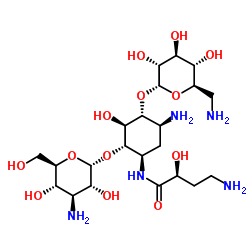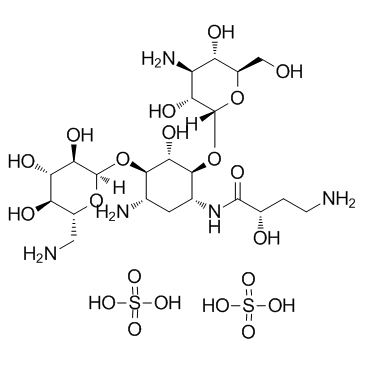Amikacin

Amikacin structure
|
Common Name | Amikacin | ||
|---|---|---|---|---|
| CAS Number | 37517-28-5 | Molecular Weight | 585.602 | |
| Density | 1.6±0.1 g/cm3 | Boiling Point | 981.8±65.0 °C at 760 mmHg | |
| Molecular Formula | C22H43N5O13 | Melting Point | 203-204ºC (sesquihydrate) | |
| MSDS | N/A | Flash Point | 547.6±34.3 °C | |
Use of AmikacinAmikacin (BAY 41-6551), a semisynthetic analog of kanamycin, is very active against most gram-negative bacteria including gentamicin- and tobramycin-resistant strains. Amikacin (BAY 41-6551) is ototoxic and nephrotoxic[1][2]. |
| Name | amikacin |
|---|---|
| Synonym | More Synonyms |
| Description | Amikacin (BAY 41-6551), a semisynthetic analog of kanamycin, is very active against most gram-negative bacteria including gentamicin- and tobramycin-resistant strains. Amikacin (BAY 41-6551) is ototoxic and nephrotoxic[1][2]. |
|---|---|
| Related Catalog | |
| References |
[1]. Edson, R.S. and C.L. Terrell, The aminoglycosides. Mayo Clin Proc, 1999. 74(5): p. 519-28. [2]. Ristuccia AM, et al. An overview of amikacin. Ther Drug Monit. 1985;7(1):12-25. |
| Density | 1.6±0.1 g/cm3 |
|---|---|
| Boiling Point | 981.8±65.0 °C at 760 mmHg |
| Melting Point | 203-204ºC (sesquihydrate) |
| Molecular Formula | C22H43N5O13 |
| Molecular Weight | 585.602 |
| Flash Point | 547.6±34.3 °C |
| Exact Mass | 585.285706 |
| PSA | 331.94000 |
| LogP | -3.34 |
| Vapour Pressure | 0.0±0.6 mmHg at 25°C |
| Index of Refraction | 1.664 |
|
Section 1. Chemical Product and Company Identification Amikacin Common Name/ Trade Name Amikacin Section 4. First Aid Measures Eye ContactCheck for and remove any contact lenses. In case of contact, immediately flush eyes with plenty of water for at
least 15 minutes. Get medical attention if irritation occurs. Skin ContactWash with soap and water. Cover the irritated skin with an emollient. Get medical attention if irritation develops. Serious Skin ContactNot available. InhalationIf inhaled, remove to fresh air. If not breathing, give artificial respiration. If breathing is difficult, give oxygen. Get medical attention. Serious InhalationNot available. IngestionDo NOT induce vomiting unless directed to do so by medical personnel. Never give anything by mouth to an unconscious person. Loosen tight clothing such as a collar, tie, belt or waistband. Get medical attention if symptoms appear. Serious IngestionNot available. Section 5. Fire and Explosion Data Flammability of the Product May be combustible at high temperature. Auto-Ignition Temperature Not available. Flash PointsNot available. Flammable LimitsNot available. Products of CombustionThese products are carbon oxides (CO, CO2). Fire Hazards in Presence of Slightly flammable to flammable in presence of heat. Various SubstancesNon-flammable in presence of shocks. Explosion Hazards in Presence Slightly explosive in presence of open flames and sparks. Non-explosive in presence of shocks. of Various Substances SMALL FIRE: Use DRY chemical powder. Fire Fighting Media and InstructionsLARGE FIRE: Use water spray, fog or foam. Do not use water jet. As with most organic solids, fire is possible at elevated temperatures Special Remarks on Fire Hazards Special Remarks on Explosion Fine dust dispersed in air in sufficient concentrations, and in the presences of an ignition source is a potential dust Hazardsexplosion hazard. Section 6. Accidental Release Measures Small SpillUse appropriate tools to put the spilled solid in a convenient waste disposal container. Finish cleaning by spreading water on the contaminated surface and dispose of according to local and regional authority requirements. Large SpillUse a shovel to put the material into a convenient waste disposal container. Finish cleaning by spreading water on the contaminated surface and allow to evacuate through the sanitary system. Amikacin Section 7. Handling and Storage PrecautionsKeep away from heat. Keep away from sources of ignition. Do not ingest. Do not breathe dust. If ingested, seek medical advice immediately and show the container or the label. StorageKeep container tightly closed. Keep container in a cool, well-ventilated area. Section 8. Exposure Controls/Personal Protection Engineering ControlsUse process enclosures, local exhaust ventilation, or other engineering controls to keep airborne levels below recommended exposure limits. If user operations generate dust, fume or mist, use ventilation to keep exposure to airborne contaminants below the exposure limit. Personal Protection Safety glasses. Lab coat. Dust respirator. Be sure to use an approved/certified respirator or equivalent. Gloves. Personal Protection in Case of Splash goggles. Full suit. Dust respirator. Boots. Gloves. A self contained breathing apparatus should be used a Large Spillto avoid inhalation of the product. Suggested protective clothing might not be sufficient; consult a specialist BEFORE handling this product. Exposure LimitsNot available. Section 9. Physical and Chemical Properties Physical state and appearance Solid. (Powdered solid.)OdorNot available. TasteNot available. Molecular Weight585.6 g/mole ColorWhite. pH (1% soln/water)Not available. Boiling PointNot available. Melting Point214°C (417.2°F) Critical TemperatureNot available. Not available. Specific Gravity Vapor PressureNot applicable. Vapor DensityNot available. VolatilityNot available. Odor ThresholdNot available. Not available. Water/Oil Dist. Coeff. Ionicity (in Water)Not available. Not available. Dispersion Properties SolubilityNot available. Section 10. Stability and Reactivity Data StabilityThe product is stable. Not available. Instability Temperature Conditions of InstabilityExcess heat, dust generation, incompatible materials Incompatibility with variousReactive with oxidizing agents. substances CorrosivityNot available. Amikacin Special Remarks onNot available. Reactivity Special Remarks onNot available. Corrosivity PolymerizationWill not occur. Section 11. Toxicological Information Routes of EntryInhalation. Ingestion. Toxicity to AnimalsAcute oral toxicity (LD50): >6000 mg/kg [Mouse]. Chronic Effects on Humans May cause damage to the following organs: kidneys, ears. Other Toxic Effects onSlightly hazardous in case of skin contact (irritant), of ingestion, of inhalation. Humans Special Remarks onNot available. Toxicity to Animals Special Remarks onMay cause adverse reproductive effects and birth defects (teratogenic) Chronic Effects on Humans Special Remarks on otherAcute Potential Health Effects: Toxic Effects on HumansSkin: May cause skin irritation. Eyes: May cause eye irritation. Inhalation: May cause respiratory tract irritation. Ingestion: May cause irritation of the digestive tract. May affect the nervous system (flaccid paralysis without anesthesia). Chronic Potential Health Effects: Ingestion: Prologned or repeated ingestion may cause kidney damage, and may affect the blood, and metabolism (weight loss), hearing (nerve deafness, change in cochlear structure or function). Aminoglycosides are associated with significant nephrotoxicity and/or ototoxicity. Section 12. Ecological Information EcotoxicityNot available. Not available. BOD5 and COD Possibly hazardous short term degradation products are not likely. However, long term degradation products may Products of Biodegradation arise. Toxicity of the ProductsThe product itself and its products of degradation are not toxic. of Biodegradation Special Remarks on theNot available. Products of Biodegradation Section 13. Disposal Considerations Waste DisposalWaste must be disposed of in accordance with federal, state and local environmental control regulations. Amikacin Section 14. Transport Information DOT ClassificationNot a DOT controlled material (United States). IdentificationNot applicable. Not applicable. Special Provisions for Transport DOT (Pictograms) Section 15. Other Regulatory Information and Pictograms No products were found. Federal and State Regulations CaliforniaCalifornia prop. 65: This product contains the following ingredients for which the State of California has found to cause cancer which would require a warning under the statute: No products were found. Proposition 65 Warnings California prop. 65: This product contains the following ingredients for which the State of California has found to cause birth defects which would require a warning under the statute: No products were found. Other RegulationsOSHA: Hazardous by definition of Hazard Communication Standard (29 CFR 1910.1200). EINECS: This product is on the European Inventory of Existing Commercial Chemical Substances. WHMIS (Canada) Not controlled under WHMIS (Canada). Other Classifications DSCL (EEC)This product is not classified according S24/25- Avoid contact with skin and eyes. to the EU regulations.S36/37/39- Wear suitable protective clothing, gloves and eye/face protection. Health Hazard HMIS (U.S.A.)1 National Fire Protection 1 Flammability 1 Association (U.S.A.) Fire Hazard 1 0 Reactivity Health Reactivity 0 Specific hazard Personal Protection E WHMIS (Canada) (Pictograms) DSCL (Europe) (Pictograms) TDG (Canada) (Pictograms) ADR (Europe) (Pictograms) Amikacin Protective Equipment Gloves. Lab coat. Dust respirator. Be sure to use an approved/certified respirator or equivalent. SECTION 16 - ADDITIONAL INFORMATION N/A |
CHEMICAL IDENTIFICATION
HEALTH HAZARD DATAACUTE TOXICITY DATA
|
|
~% 
Amikacin CAS#:37517-28-5 |
| Literature: WO2010/30690 A1, ; Page/Page column 17-18 ; WO 2010/030690 A1 |
| Precursor 1 | |
|---|---|
| DownStream 0 | |
|
Enhancement of in vitro activity of tuberculosis drugs by addition of thioridazine is not reflected by improved in vivo therapeutic efficacy.
Tuberculosis (Edinb.) 94(6) , 701-7, (2015) Assessment of the activity of thioridazine towards Mycobacterium tuberculosis (Mtb), in vitro and in vivo as a single drug and in combination with tuberculosis (TB) drugs.The in vitro activity of thio... |
|
|
Aminoglycosides suppress the protein folding activity of the molecular chaperone HSC70: implication of a structure-activity relationship.
Chemotherapy 60(1) , 37-46, (2014) The mechanism of aminoglycoside (AG)-induced nephrotoxicity has not been fully elucidated. We previously reported that gentamicin suppresses the functions of HSC70, a heat shock cognate protein, which... |
|
|
Phenotypic heterogeneity enables uropathogenic Escherichia coli to evade killing by antibiotics and serum complement.
Infect. Immun. 83(3) , 1056-67, (2015) Uropathogenic strains of Escherichia coli (UPEC) are the major cause of bacteremic urinary tract infections. Survival in the bloodstream is associated with different mechanisms that help to resist ser... |
| Butanamide, 4-amino-N-[(1R,2S,3S,4R,5S)-5-amino-2-[(3-amino-3-deoxy-α-D-glucopyranosyl)oxy]-4-[(6-amino-6-deoxy-α-D-glucopyranosyl)oxy]-3-hydroxycyclohexyl]-2-hydroxy-, (2S)- |
| Butanimidic acid, 4-amino-N-[(1R,2S,3S,4R,5S)-5-amino-2-[(3-amino-3-deoxy-α-D-glucopyranosyl)oxy]-4-[(6-amino-6-deoxy-α-D-glucopyranosyl)oxy]-3-hydroxycyclohexyl]-2-hydroxy-, (1E,2S)- |
| kaminax |
| (2S)-4-amino-N-{(1R,2S,3S,4R,5S)-5-amino-2-[(3-amino-3-deoxy-a-D-glucopyranosyl)oxy]-4-[(6-amino-6-deoxy-a-D-glucopyranosyl)oxy]-3-hydroxycyclohexyl}-2-hydroxybutanamide |
| novamin |
| 1-N-[L(-)-4-Amino-2-hydroxybutyryl]kanamycin A |
| mikavir |
| D-Streptamine |
| AMIKACIN |
| bb-k8 |
| Amikin |
| EINECS 253-538-5 |
| butanamide, 4-amino-N-[(1R,2S,3S,4R,5S)-5-amino-2-[(3-amino-3-deoxy-a-D-glucopyranosyl)oxy]-4-[(6-amino-6-deoxy-a-D-glucopyranosyl)oxy]-3-hydroxycyclohexyl]-2-hydroxy-, (2S)- |
| (1E,2S)-4-Amino-N-{(1R,2S,3S,4R,5S)-5-amino-2-[(3-amino-3-deoxy-α-D-glucopyranosyl)oxy]-4-[(6-amino-6-deoxy-α-D-glucopyranosyl)oxy]-3-hydroxycyclohexyl}-2-hydroxybutanimidic acid |
| Amikacin Base |
| Fabianol |
| lukadin |
| Biklin |
| amiklin |
| (2S)-4-Amino-N-{(1R,2S,3S,4R,5S)-5-amino-2-[(3-amino-3-deoxy-α-D-glucopyranosyl)oxy]-4-[(6-amino-6-deoxy-α-D-glucopyranosyl)oxy]-3-hydroxycyclohexyl}-2-hydroxybutanamide |
| O-3-Amino-3-deoxy-a-D-glucopyranosyl-(1®6)-O-[6-amino-6-deoxy-a-D-glucopyranosyl-(1®4)]-N1-(4-amino-2-hydroxy-1-oxobutyl)-2-deoxy-D-streptamine |
| AMK |
